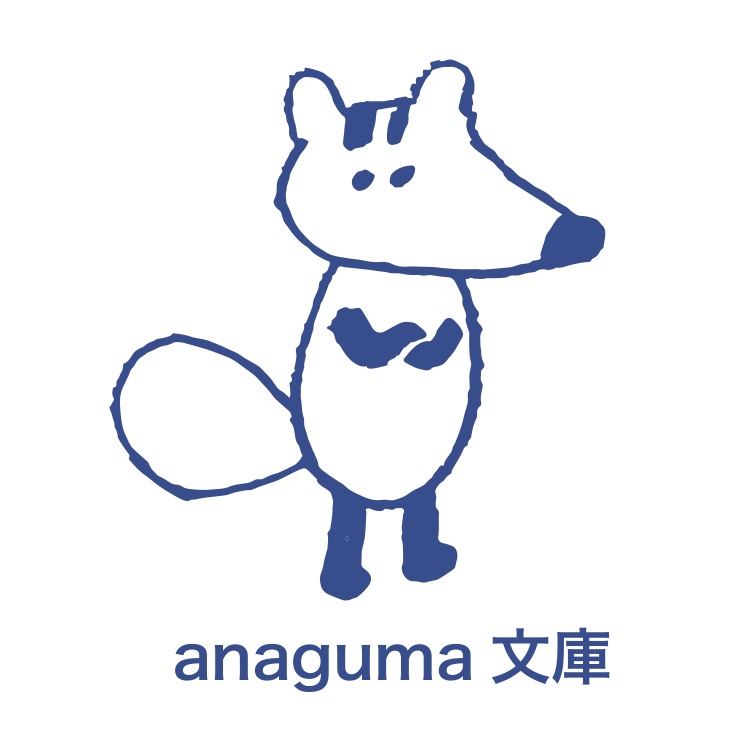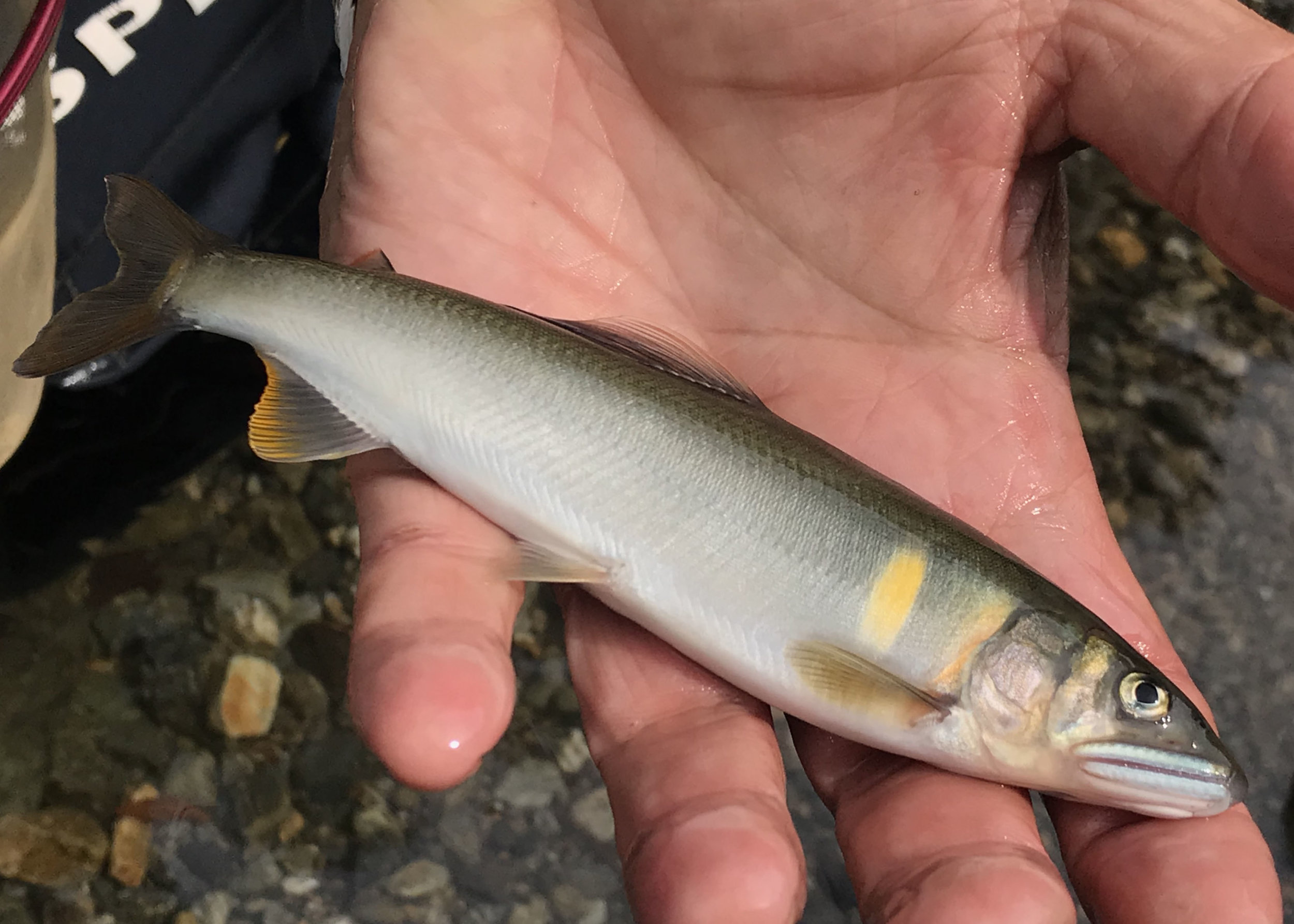(Please scroll down for the English version.)
黄色い縞を探す
鮎釣り教室で最初に教えてもらったのは、天然鮎と養殖鮎の見分け方だった。「天然鮎はこの辺が黄色やで」とおじさんは胸ヒレの近くの黄色い縞を指した。とても爽やかな色彩だった。教室の参加者は中奥川沿いの駐車場で集合した。僕らは長靴とズボンとサスペンダーの組み合わせである胴長(ウェーダー)を履き、竿とタモ網と友舟を漁業組合から借りた。
僕は先生と一緒に歩きながら、目の下で流れる中奥川をよく見た。「鮎がいる川というのは、ピカッと光っとるねん」と彼は言った。僕らは川の大きな石まで下り、道具を準備した。先生は友舟から鮎1匹を出し、ハリの付け方を見せてくれた。オトリ鮎の鼻と背と尻ヒレにハリを付けた。糸の最後に、3本束ねたイカリのような「掛バリ」がまだ残っていた。ナワバリ意識の高まった天然鮎は、オトリ鮎を見て闘争にきたら、この掛バリに引っかかる。この釣り方は「友釣り」と呼ばれているが、僕は鮎同士の友情をあまり感じない。
僕は膝まで川に入り、長い竿を両手で持ちながら、先生の指導を受けた。おとり鮎をちゃんと泳がせるために、竿と糸の角度を水平に近くした。次の2時間で鮎釣りの「山あり谷あり」を経験した。早速アタリが出たが、逃げてしまったみたい。竿の感覚でまたアタリが出たと思った時、自分の掛バリに引っかかったオトリ鮎だけだった。こういう曲がりくねった姿になった鮎を「エビ」と呼ぶって。そのうち、黄色い縞のある天然鮎を何匹も釣れた。元気な天然鮎を疲れたオトリ鮎と入れ替えた。天然のオトリ鮎は流れのきついところで頑張って泳いでくれた。「養殖のオトリはああいうところでよう上れへん。天然やから、違う。食べても違うね」と先生は笑った。
この鮎釣り教室は海の日に全国豊かな海づくり大会、奈良県と川上村の漁業組合に開催された。川の水が海まで流れるから、豊かな海をつくることは山から始まる。また、綺麗な川で苔を食べる天然鮎は育ち、生き生きした黄色い縞を見せてくれる。今まで中奥川が大切にされたおかげで、僕は鮎釣りの楽しさ、天然鮎のうまさを知る機会があった。その夜、釣れた鮎に塩をかけて炙り、友達と一緒に食べた。
Searching for the Yellow Stripe
The first thing I was taught in the ayu fishing class was how to distinguish wild ayu from raised ayu. “This part of wild ayu is yellow, ya’know,” the old man said as he pointed at a yellow stripe near the pectoral fin. It was a very fresh shade of yellow. Participants in the class gathered at a parking lot along the Nakaoku River. We stepped into our boots-pants-suspenders combination known as “waders”, and each borrowed a rod, scoop net, and fish carrier from the fisherman’s cooperative.
While I was walking with my teacher, I looked down at the Nakaoku River flowing below us. “Rivers with ayu in them, it’s like they’re just glistening,” he said. We climbed down to the large rocks on the river and set up our equipment. My teacher grabbed one ayu from the fish carrier and showed me how to attach the hooks. He attached hooks to the nose, back, and anal fin of the otori-ayu. At the end of the line was the kakebari hook, which looked like three anchors bound together. When the territorial wild ayu see and attack the otori-ayu, they are caught on the kakebari hook. This method of fishing is called tomotsuri, or “friend fishing”, but I don’t sense a whole lot of friendship between the ayu fish.
I walked into the river up to my knees, held the long rod with both hands, and followed my teacher’s directions. In order to let the otori-ayu swim properly, I held the rod and line at nearly a horizontal angle. Over the next two hours, we experienced the “mountains and valleys” of ayu fishing. We caught one right off the bat, but apparently it got away. When the rod felt like I had caught another one, it was just the otori-ayu caught on its own kakebari hook. When ayu are in this kind of twisted pose, they are called “shrimp”. In time, we also caught a few wild ayu with yellow stripes. We replaced the tired otori-ayu with an energetic wild ayu. Now, the wild otori-ayu swam vigorously through the rough currents. “A raised ayu wouldn’t be able to swim in those waters. The wild ones are different though. They’re different when you eat’em, too,” my teacher laughed.
This ayu fishing class was held on Marine Day by the National Rich Ocean Creation Congress, and the fisherman’s cooperatives of Nara Prefecture and Kawakami Village. Since the river’s water flows to the ocean, creating a rich ocean begins in the mountains. Also, the wild ayu who eat moss in these clean rivers grow up and show us their lively yellow stripes. Thanks to the Nakaoku River having been taken care of up to now, I had the opportunity to know both the joy of ayu fishing and the delicious taste of wild ayu. That night, I sprinkled some salt on the ayu I caught, broiled them, and enjoyed them with my friends.



